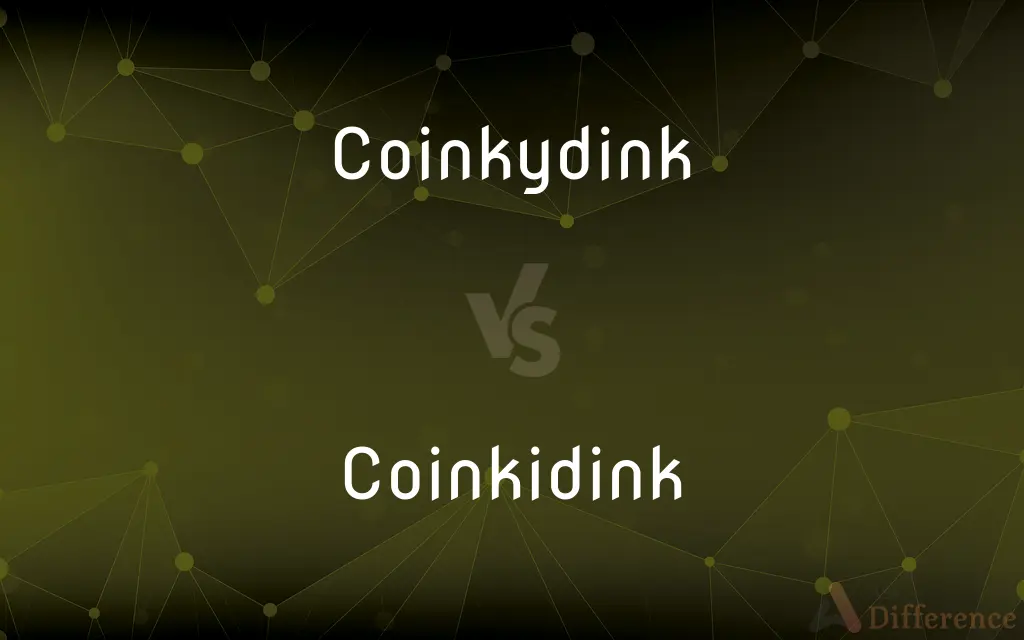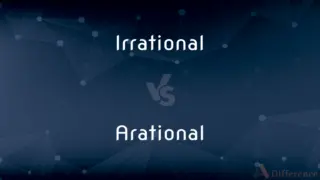Coinkydink vs. Coinkidink — What's the Difference?
By Tayyaba Rehman & Fiza Rafique — Updated on April 9, 2024
Coinkydink, a playful alteration of "coincidence," emphasizes serendipity with a humorous tone, while coinkidink, another whimsical variant, underscores the same notion with an even more casual, childlike flair.

Difference Between Coinkydink and Coinkidink
Table of Contents
ADVERTISEMENT
Key Differences
Coinkydink is a slang term that playfully modifies "coincidence" to inject humor and a sense of lightheartedness into the conversation. It's used to describe events that happen at the same time by chance but have no causal relationship, highlighting the unpredictability of life. Whereas coinkidink, with its slightly altered spelling and pronunciation, serves a similar purpose. It emphasizes the whimsicality of coincidental events, often used in even more informal or affectionate contexts.
The use of coinkydink often conveys a sense of surprise or amusement at the occurrence of two unrelated events happening simultaneously. It’s typically used in casual conversations to express a playful acknowledgment of serendipity. On the other hand, coinkidink, by virtue of its "kid-like" phonetics, might be preferred in contexts or among speakers who wish to evoke a more pronounced sense of playfulness or endearment, possibly appealing more to a younger audience or those seeking a stronger departure from formality.
Both terms are examples of how language evolves and adapts to cultural and social nuances. Coinkydink, with its quirky twist on a common term, reflects a creative approach to language that delights in the unexpected. Whereas coinkidink takes this creativity a step further, suggesting an even more informal and spontaneous attitude towards coincidental occurrences.
The choice between coinkydink and coinkidink may also reflect the speaker's personal style or the specific nuance they wish to convey. While both terms serve to lighten the conversation, coinkydink might be seen as slightly more adult-like compared to the more whimsical and childlike coinkidink.
In literary or narrative contexts, coinkydink can be a stylistic device to introduce a coincidence in a story with a touch of humor. It signals to the reader that the coincidence should not be taken too seriously. Coinkidink, meanwhile, might be employed for similar reasons but in works targeting a younger audience or seeking to establish a particularly playful or whimsical tone.
ADVERTISEMENT
Comparison Chart
Origin
Playful alteration of "coincidence"
Another playful alteration, emphasizing a more whimsical tone
Tone
Humorous, light-hearted
Even more casual, childlike
Context
Casual conversations among adults
Preferred in more informal, possibly younger contexts
Audience Appeal
General audience appreciating humor
Appeals to those enjoying a pronounced playfulness or whimsy
Usage
Used to highlight serendipity with amusement
Evokes a stronger sense of playfulness and endearment
Compare with Definitions
Coinkydink
A humorous take on coincidence.
Running into you here is such a coinkydink!
Coinkidink
Conveys a more pronounced playfulness.
This matching outfit scenario is a funny coinkidink.
Coinkydink
Emphasizes chance in a playful manner.
That we both thought of the same song is a funny coinkydink.
Coinkidink
Signals whimsical serendipity.
Both of us getting the same idea is such a coinkidink!
Coinkydink
Used to express serendipity with a smile.
Finding the last piece just when we needed it, what a coinkydink!
Coinkidink
A childlike twist on coincidence.
Meeting your new friend at the park too? That’s a cute coinkidink!
Coinkydink
Casual remark on unexpected connections.
Our moms attending the same school is quite the coinkydink.
Coinkidink
Highlights unexpected occurrences with a whimsical touch.
Seeing a double rainbow today too? That’s a magical coinkidink!
Coinkydink
Light-hearted acknowledgment of synchronicity.
Wearing the same dress, huh? What a coinkydink!
Coinkidink
Indicates a surprising connection in a playful tone.
You’ve got the same lunch as me today? What a coinkidink!
Coinkydink
A coincidence.
Coinkidink
A coincidence.
Common Curiosities
Is coinkidink a real word?
While not recognized in formal English dictionaries, coinkidink is a real slang term used colloquially.
Why would someone use coinkydink instead of coincidence?
To add a playful or humorous tone to the observation of a chance event.
Can coinkydink be used in formal writing?
Coinkydink is best suited for casual or informal contexts, not formal writing.
Do coinkydink and coinkidink have the same origin?
Yes, both are playful alterations of the word "coincidence."
What does coinkydink mean?
Coinkydink is a playful, humorous way to refer to a coincidence.
How is coinkidink different from coinkydink?
Coinkidink is even more casual and childlike than coinkydink, emphasizing whimsy.
Are coinkydink and coinkidink interchangeable?
They are largely interchangeable but differ slightly in tone, with coinkidink being more whimsical.
How can coinkydink affect the tone of a story or message?
It can introduce a casual, humorous tone, making the narrative more relatable and entertaining.
Does the use of coinkidink vary by region?
Its usage might vary, with some regions or cultural groups finding it more appealing or humorous than others.
Can using coinkydink make conversations more engaging?
Yes, it can add a light-hearted, humorous element to conversations about coincidences.
Is it common to hear coinkidink in everyday language?
It's more common in casual, informal conversations, especially among younger speakers or in playful contexts.
How do coinkydink and coinkidink reflect language evolution?
They showcase how language adapts to convey nuances of tone and emotion, even in the description of common concepts like coincidence.
Is there a right context to use coinkidink?
Coinkidink fits best in very informal, playful, or child-oriented conversations.
Can coinkydink be used sarcastically?
Yes, it can be used to highlight the absurdity or improbability of a coincidence with a sarcastic undertone.
Share Your Discovery

Previous Comparison
Irrational vs. Arational
Next Comparison
Oppression vs. RepressionAuthor Spotlight
Written by
Tayyaba RehmanTayyaba Rehman is a distinguished writer, currently serving as a primary contributor to askdifference.com. As a researcher in semantics and etymology, Tayyaba's passion for the complexity of languages and their distinctions has found a perfect home on the platform. Tayyaba delves into the intricacies of language, distinguishing between commonly confused words and phrases, thereby providing clarity for readers worldwide.
Co-written by
Fiza RafiqueFiza Rafique is a skilled content writer at AskDifference.com, where she meticulously refines and enhances written pieces. Drawing from her vast editorial expertise, Fiza ensures clarity, accuracy, and precision in every article. Passionate about language, she continually seeks to elevate the quality of content for readers worldwide.















































